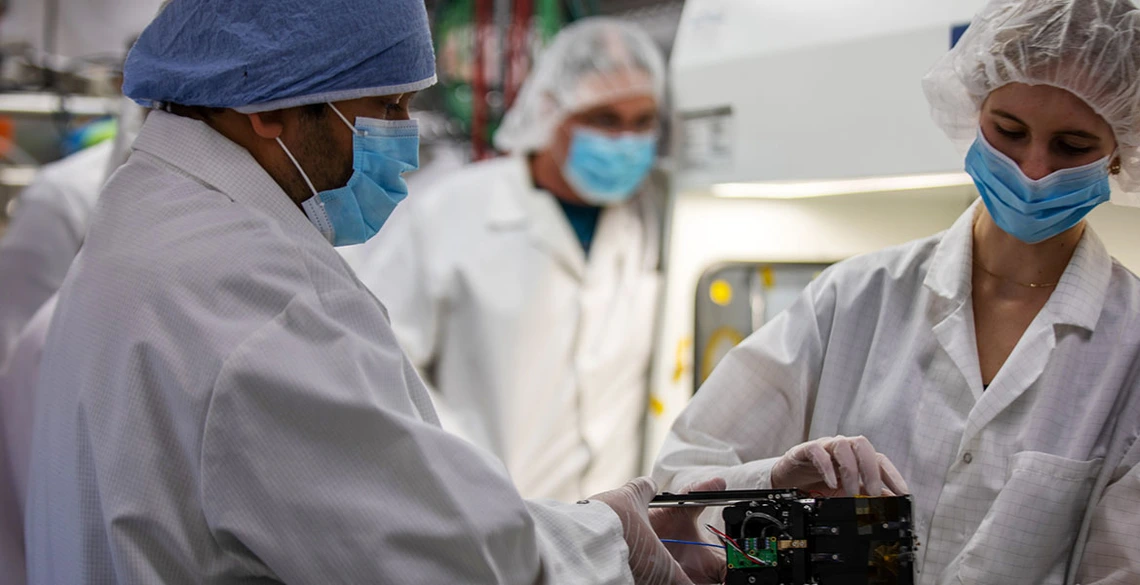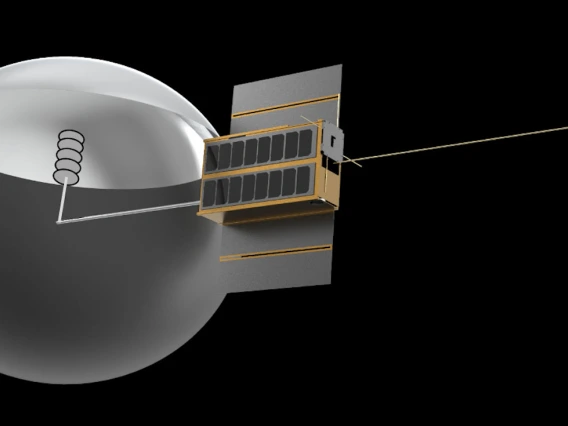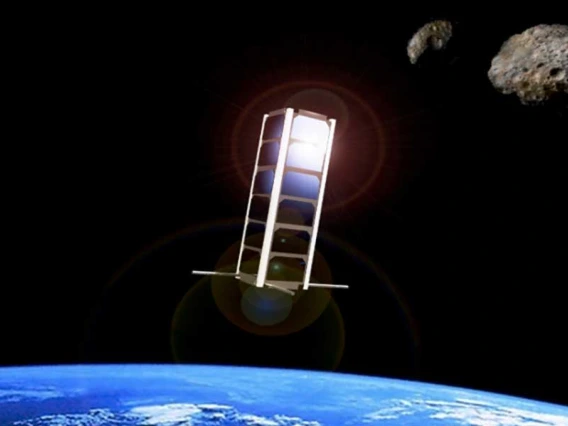Student-built Satellite Uses 'Beach Ball' for an Antenna
CatSat is a small satellite carrying a new communications concept – an inflatable antenna – into space.

Engineering students Aman Chandra (left) and Shae Henley are two of many UA students who have helped prepare CatSat for launch. Here, they carefully handle the system that will eject and inflate a large mylar membrane in space. The upper half of the ball-shaped antenna is reflective, so it can relay electromagnetic waves to Earth. TaMya Reliford, University of Arizona
Near the University of Arizona’ main campus, students gather inside a cleanroom wearing lab coats, gloves and hairnets. On their lab bench sits a complex maze of wires and metal, the dimensions of a family-size cereal box. Each component has been optimized to survive a rocket launch and orbit the Earth.
After years of designing, building and testing, a team of students has readied CatSat, a small satellite known as a CubeSat, for launch into space. The spacecraft was designed to demonstrate new space technology and overcome a major challenge in space exploration: high-speed, low-cost communication across vast distances. Reminiscent of a beach ball, the satellite's antenna is expected to transfer information from space to Earth at high data rates.
The satellite is planned to probe the ionosphere – a layer of charged particles at the boundary between the Earth's atmosphere and space – so that the team can better understand the ionosphere's ever-changing structure. This structure impacts the propagation of high-frequency radio signals.
CubeSats are miniature cube-shaped satellites that orbit Earth and range in size from a 10-centimeter cube to a desktop computer. CubeSats are made with modular, relatively low-cost components.
Unlike other CubeSats, CatSat has an inflatable antenna, developed by Freefall Aerospace, a Tucson-based startup company and spinoff that was brought to be with the help of the university's commercialization arm, Tech Launch Arizona. Stored inside of CatSat is a high-performance, software-defined radio named AstroSDR, which was designed, built and donated by Rincon Research Corporation. After launch, the inflatable antenna, AstroSDR and other components will work together to send down high-resolution images of Earth almost instantaneously.
"Following a successful launch, this inflatable antenna will be the first of its kind in space," said Hilliard Paige, a systems engineering student and the project's lead systems engineer. "If it works, it will be a pathfinder for future missions."
Inflatable Antennas Could Give an Edge to Small Spacecraft
All spacecraft require antennas to transmit and receive signals, allowing for communication with Earth. Yet, the capabilities of CubeSat antennas have historically been restricted, as CubeSats can only carry very small antennas. Signals from these small antennas can take days to finally reach Earth.
CatSat's inflatable antenna, invented at the UA and further developed by Freefall Aerospace, combats this problem thanks to its lightweight material that tightly folds within the spacecraft. After launch, CatSat will stabilize its orientation so that it can eventually deploy the stowed antenna membrane and inflate it with helium and argon gas.
This inflated membrane is not unlike a large, floating foil birthday balloon. It has a clear lower hemisphere and an aluminum-coated upper hemisphere designed to reflect signals back down to Earth. The antenna's large surface allows for downlink speeds many times faster than comparable CubeSats.
Freefall Aerospace and the CatSat student team hope that inflatable antennas could level the playing field, allowing smaller and cheaper spacecraft to explore places beyond Earth.
"This technology could drive down the cost of high-quality scientific measurements in space by enabling the use of lightweight, low-cost antennas with very high data rates," said Aman Chandra, a doctoral student in mechanical engineering who is responsible for much of CatSat's mechanical design, including the inflatable antenna system.
Scientific Exploration of the Ionosphere
On the opposite end of CatSat's inflatable antenna is a "whip" antenna, about 2 feet long and shaped like a protruding stick. It was designed to receive low-power, automated, high-frequency beacons from thousands of Earthbound amateur radio enthusiasts. Radio signals in the high-frequency range can bounce off or refract from the ionosphere and travel to far-reaching locations by "bending around the Earth." Amateur, or ham, radio takes advantage of this charged layer of the atmosphere to broadcast information all around the globe.
"The ionosphere's density changes between night and day as radiation from the sun affects the density of its charged particles," Chandra said. "By listening to the strength of radio signals in the high-frequency range, we can estimate how the density of the ionosphere changes over time.”
The ionosphere's mysterious, fluctuating density can sometimes alter the precision of GPS signals. Minuscule alterations can be both inconvenient and catastrophic depending on the application. Because of this, the students believe it is essential to understand how the ionosphere behaves at all times.
CatSat will listen from above the ionosphere to high-frequency radio signals using the whip antenna and Rincon Research radio. The CatSat team will then compare these signals to what Earthbound radio operators hear. In this way, the team plans to identify trends in ionospheric properties in order to better understand how they change from day to night.
The Student Experience
Shae Henley is an undergraduate who began working on CatSat during her first year at the university, where she majors in aerospace engineering. Since then, some daily tasks have included hands-on assembly of the spacecraft, as well as repairing and testing balloons for the inflatable antenna.
"I love working in the cleanroom with CatSat and I'm very lucky to have this experience as only a junior in college," Henley said. "Working on CatSat has helped me become more comfortable in a work environment where I can apply what I'm learning in school."
However, the work wasn't always easy. While working on space hardware, the students encountered difficulties that sometimes forced them to change their plans and designs.
"Many pieces on the CatSat weren't our first choice," said Del Spangler, a graduate student in electrical and computer engineering and the project's lead electrical engineer. "While some of the hardware isn't necessarily meant for space, we've still been able to make it work."
"From a CubeSat to a billion-dollar space mission, there's always going to be challenges," said Dathon Golish, a scientist in the UArizona Lunar and Planetary Laboratory who previously led CatSat activities.
Other major setbacks included a damaged piece of equipment and a faulty battery that delayed development by six months.
"At moments, working on the CatSat has been frustrating, as engineering often is," Spangler said. "But overcoming all of the difficult problems we've faced has been a really good feeling."
Waiting for a Ride
Once CatSat is assigned a launch date, expected later this year, a Firefly Alpha rocket will lift it into an orbit 340 miles above Earth, the approximate distance from Phoenix to Los Angeles. The satellite will remain in a sun-synchronous orbit, a path that will almost always keep it in direct sunlight and out of Earth's shadow. Once it has launched from Vandenburg Space Force Base in California, the responsibilities of the student team are far from over.
"I'm in the process of getting my ham radio license so that I'll be able to communicate with CatSat in orbit," Henley said. "From our CatSat UHF (ultra-high-frequency) ground stations, we'll collect ionospheric data and check up on how the satellite is doing."
One of the ground stations that will be listening to CatSat's signals is a 6-meter dish antenna located at the UA's Biosphere 2. If the antenna functions correctly, it will provide images of Earth in close to real time, proving its effectiveness for quick data transfer.
"Students working on a CubeSat mission have the opportunity to see the whole life cycle of a space mission from start to finish," Golish said. "Regardless of end results, CatSat is already an accomplishment because it's given these students experience that's very difficult to come by otherwise."



